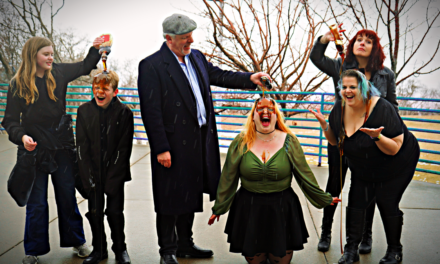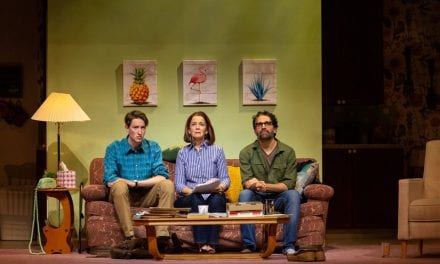 OGDEN — Last night at the Eccles Theater at Weber State University, I attended a lovely production of Our Town. The “lovely” I use here is in the British sense which connotes not just what is pleasing to the eye, but also that which is heard, felt and experienced. As in “what a lovely melody,” or “how lovely it is to see you again.” This word kept coming to my mind throughout the play, and at the end I found myself saying aloud: “What a lovely show!”
OGDEN — Last night at the Eccles Theater at Weber State University, I attended a lovely production of Our Town. The “lovely” I use here is in the British sense which connotes not just what is pleasing to the eye, but also that which is heard, felt and experienced. As in “what a lovely melody,” or “how lovely it is to see you again.” This word kept coming to my mind throughout the play, and at the end I found myself saying aloud: “What a lovely show!”
Director Larry Dooley pulled together a very talented group of actors and designers to tell Thornton Wilder’s seemingly simple story of small town American life at the turn of 20th century. This group lived the tale for the audience and invited us to find the similarities in our own lives with the citizens Grover’s Corners.
The seating for the production was set up like a sporting event with risers facing each other. The small stage between the seats made for a kind of “theater-in-the-rectangle” that was surprisingly intimate and effective. Each square foot of the area was utilized with action naturally facing all directions, making it easy to see faces and hear conversations.
The ensemble of 14 actors and 2 musicians were a seamless team. Actors took on multiple rolls and plied the sidelines as Foley artists supplying sound effects.
In a play like Our Town where the dialogue and action is deceptively simple and “normal,” I have seen productions that have tried too hard to make it more than it is. This production understood that beauty and discovery can often be motivated by the mundane. All of the actors did a wonderful job of keeping the dialogue and interaction real and sincere. Especially engaging were Megan Hall and Austin Archer, who played Emily and George, in stellar performances. The soda fountain scene was a highlight of the show. The director staged the two facing each other at a table rather than facing the audience at a counter, as is usually done. This caused the actors to look straight into each others eyes, hiding nothing. Both the dialogue and the silences were filled with honest and earnest communication. The audience was completely caught up in the scene, smiling, sighing and believing.
The Director’s notes state: “In New England, the annual changing color of the leaves is a dramatic reminder of the cycle of death and life in which we all participate.” This autumnal pallet tied together the designers of lights, costumes and sets. Lighting used break-up patterned overheads in gold, orange and red. The costumes went from a light cream, into tan toast, rust and deep chocolate. The big old oak tree on the back wall was made of warm unfinished boards and gave the impression that it had been growing for hundreds of years watching over the scene.
Another creative touch to the show was the music. Each act started with a church choir hymn. Thereafter, guitarist Aaron Cole and Christoper Shenefelt provided a subtle soundtrack to the play. Melodies would appear and disappear almost unnoticed. These added perfectly to the mood of scenes and conversations, but were never distracting .
Before ending this review, I must praise the cement of this play. Trent Cox did a masterful job as the Stage Manager. He set the pace of the show, interacted with the audience and the actors, and brought forward the tone for each act. He seemed so friendly and neighborly, that I wanted to invite him home for dinner.
This production continues it’s run through April 17. I suggest that you treat yourself to this fine performance of a lovely, in every sense, rendition of a classic.
Questions for Our Readers
- Pioneer Theatre Company also recently produced a production of Our Town. If you saw both productions, which one you like more and why?
- The action of Our Town takes place roughly 100 years ago, yet still speaks to the American experience. Why is the message of the play still relevant when life is so different now?
- If you grew up or now live in a small town, what aspects of Our Town best communicate life in a small town?




